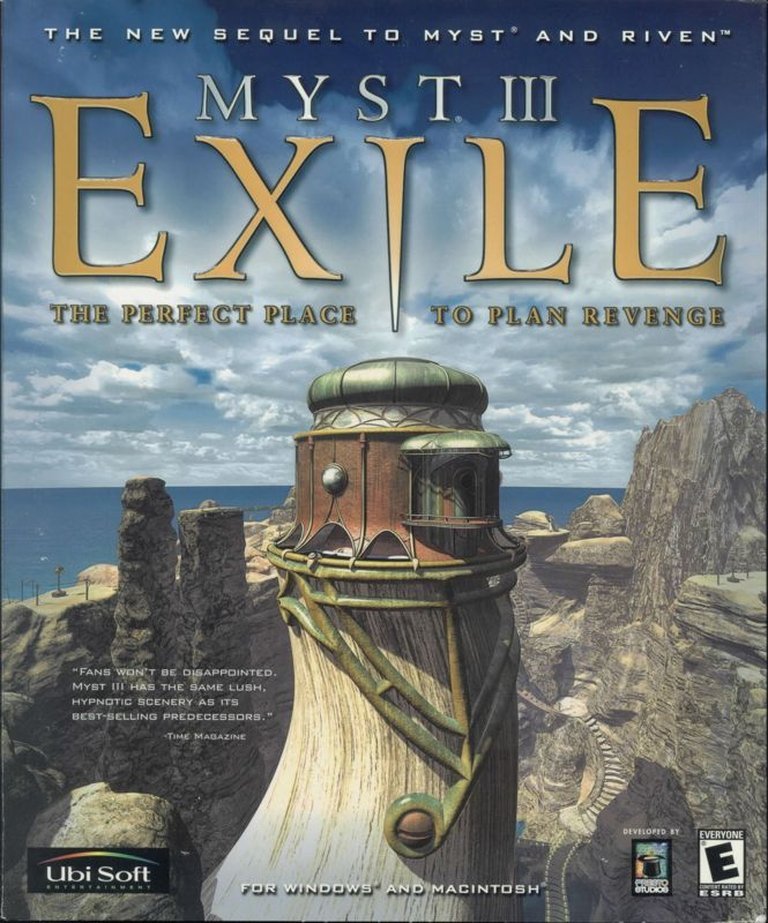- Release Year: 2001
- Platforms: Macintosh, PlayStation 2, Windows, Xbox
- Publisher: Ubi Soft Entertainment Software
- Developer: Presto Studios, Inc.
- Genre: Adventure
- Perspective: First-person
- Game Mode: Single-player
- Gameplay: Graphic adventure, Point and click, Puzzle elements
- Setting: Fantasy, Steampunk
- Average Score: 80/100

Description
Myst III: Exile is a first-person point-and-click adventure game set ten years after the events of Riven, where the player must track down a thief named Saavedro who has stolen a crucial book, navigating through various Ages and solving puzzles to unravel the narrative and ultimately determine the outcome, influenced by the player’s decisions.
Where to Buy Myst III: Exile
PC
Myst III: Exile Free Download
Patches & Updates
Mods
Guides & Walkthroughs
Reviews & Reception
metacritic.com (83/100): Few recent graphic adventures get as many things right as Exile does. It reminds you of why you began playing adventure games in the first place.
imdb.com : Myst III: Exile is the finest game ever, not only are the graphics spectacular and the sound amazing (the soundtrack alone is equal to if not better than most movie soundtracks), but the surreal location actually seems believable.
gamespot.com : Myst III: Exile builds on the legacy of the series and provides an almost magical sense of wonder.
mobygames.com (77/100): A beautiful new chapter to the Myst series that fans will love.
Myst III: Exile: Review
Introduction
Myst III: Exile is a landmark title in the adventure game genre, building upon the legacy of its predecessors while introducing innovative features that enhanced the gaming experience. Developed by Presto Studios and published by Ubi Soft, Exile continues the Myst series’ tradition of puzzle-based exploration through pre-rendered environments known as Ages. This review will analyze Exile’s development history, narrative, gameplay mechanics, world-building, reception, and legacy, providing a comprehensive understanding of its place in video game history.
Development History & Context
The development of Myst III: Exile was a significant undertaking by Presto Studios, a developer known for their work on The Journeyman Project series. Presto was chosen by Cyan Worlds and Mattel Interactive to develop the third Myst game due to their expertise and existing partnership. The project required a substantial budget and spanned over two years, with a focus on delivering diverse visual environments and a nuanced antagonist. The game’s development was influenced by the technological constraints of the era, including the use of pre-rendered backgrounds and live-action sequences.
Narrative & Thematic Deep Dive
Exile’s narrative takes place ten years after the events of Riven, with the player visiting Atrus and his wife Catherine at their home, Tomahna. The story unfolds as the player pursues Saavedro, a man seeking revenge against Atrus for past wrongs committed by his sons. The game’s narrative is characterized by its use of journals, visual cues, and video messages to convey the story, providing a rich and immersive experience. The themes of revenge, redemption, and the consequences of one’s actions are central to the narrative, adding depth to the game’s world and characters.
Gameplay Mechanics & Systems
Exile’s gameplay mechanics build upon the series’ signature style of puzzle-based exploration. The game introduces a 360-degree “free look” system, allowing players to explore environments in greater detail. The game’s central hub, J’nanin, serves as a tutorial for the gameplay mechanics, connecting to three major Ages: Amateria, Edanna, and Voltaic. Each Age presents unique puzzles and challenges, requiring players to observe and interact with the environment to progress. The game’s optional “zip” feature allows for fast travel across familiar areas, streamlining the gameplay experience.
World-Building, Art & Sound
The world-building in Exile is a standout aspect of the game, with each Age presenting a distinct and immersive environment. The game’s art direction is characterized by its use of pre-rendered backgrounds, creating a visually stunning experience. The soundtrack, composed by Jack Wall, is a significant improvement over the previous games, providing a rich and atmospheric score that complements the game’s world and narrative. The sound design is also noteworthy, with realistic sound effects and voice acting that enhance the overall experience.
Reception & Legacy
Exile received widespread critical acclaim upon its release, with praise for its graphics, sound, and gameplay mechanics. The game was considered a worthy addition to the Myst series, with many reviewers noting its improved narrative and puzzle design. The game was also a commercial success, selling over one million copies within its first year. However, it underperformed compared to its predecessors, which had collectively sold nearly 10 million units. Exile’s legacy is significant, as it continued the Myst series’ tradition of innovative gameplay and storytelling, influencing the adventure game genre as a whole.
Conclusion
Myst III: Exile is a landmark title in the adventure game genre, building upon the legacy of its predecessors while introducing innovative features that enhanced the gaming experience. The game’s narrative, gameplay mechanics, and world-building are all noteworthy aspects of the game, providing a rich and immersive experience for players. While it may not have achieved the same level of commercial success as its predecessors, Exile’s influence on the genre is undeniable. As a testament to its enduring quality, Exile remains a beloved game among fans of the series and adventure games in general.